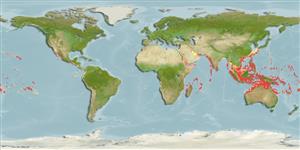Environment: milieu / climate zone / depth range / distribution range
Ecología
marino asociado a arrecife; rango de profundidad 1 - 130 m (Ref. 37816), usually 1 - 20 m (Ref. 90102). Tropical; 32°N - 23°S
Indo-Pacific: Red Sea to the Marquesan and Mangaréva islands, north to southern Japan, south to New Zealand (Ref. 5755).
Tamaño / Peso / Age
Maturity: Lm ? range ? - ? cm
Max length : 30.0 cm TL macho / no sexado; (Ref. 9710)
Espinas dorsales (total): 7; Radios blandos dorsales (total): 13-14; Espinas anales 2; Radios blandos anales: 9. Body dark brown with yellow stripes; small juveniles with spots, specimens up to 5 cm SL with 3 stripes, specimens at least 8 cm SL with 6 stripes, the number of stripes increases and may break into a series of dashes in large adults (Ref. 4326).
Inhabits coastal waters over corals and rocky substrates (Ref. 5213, 48635). Usually hides beneath ledges and small caves during the day (Ref. 4326, 48635). Small juveniles have only two white stripes, dividing with growth into numerous lines. The lines break-up into dashes and spots when adult (Ref. 48635). Feeds on fishes (Ref. 4821). Has toxin-producing glands in the dermis (Ref. 4326) which is extremely bitter to the taste (Ref. 11441). Minimum depth reported taken from Ref. 30874.
Life cycle and mating behavior
Madurez | Reproducción | Puesta | Huevos | Fecundidad | Larva
Randall, J.E., 1986. Grammistidae. p. 537-538. In M.M. Smith and P.C. Heemstra (eds.) Smiths' sea fishes. Springer-Verlag, Berlin. (Ref. 4326)
IUCN Red List Status (Ref. 130435)
Threat to humans
Reports of ciguatera poisoning (Ref. 31637)
Human uses
Pesquerías: escaso valor comercial; Acuario: Comercial
Más información
Nombres comunesSinónimosMetabolismoDespredadoresEcotoxicologíaReproducciónMadurezPuestaAgregación para la puestaFecundidadHuevosEgg development
ReferenciasAcuiculturaPerfil de acuiculturaRazasGenéticaElectrophoresesheritabilidadEnfermedadesProcesamientoNutrientsMass conversion
Herramientas
Special reports
Download XML
Fuentes de Internet
Estimates based on models
Preferred temperature (Ref.
123201): 25.2 - 29, mean 27.9 °C (based on 1014 cells).
Phylogenetic diversity index (Ref.
82804): PD
50 = 1.0000 [Uniqueness, from 0.5 = low to 2.0 = high].
Bayesian length-weight: a=0.01148 (0.00451 - 0.02922), b=3.06 (2.84 - 3.28), in cm total length, based on LWR estimates for this (Sub)family-body shape (Ref.
93245).
Nivel trófico (Ref.
69278): 4.0 ±0.66 se; based on food items.
Fishing Vulnerability (Ref.
59153): Low vulnerability (20 of 100).
Nutrients (Ref.
124155): Calcium = 45.4 [26.7, 86.2] mg/100g; Iron = 0.546 [0.292, 0.901] mg/100g; Protein = 18.5 [16.7, 20.2] %; Omega3 = 0.176 [0.116, 0.268] g/100g; Selenium = 35.6 [20.9, 61.3] μg/100g; VitaminA = 114 [40, 361] μg/100g; Zinc = 1.1 [0.8, 1.6] mg/100g (wet weight);
